
Sempervivum is a genus of about 40 species of flowering plants in the family Crassulaceae, commonly known as houseleeks. Other common names include liveforever and hen and chicks, a name shared with plants of other genera as well. They are succulent perennials forming mats composed of tufted leaves in rosettes. In favourable conditions they spread rapidly via offsets, and several species are valued in cultivation as groundcover for dry, sunny locations.
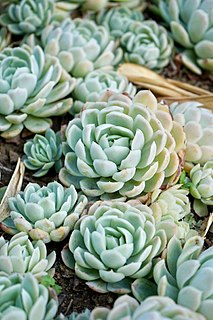
Echeveria is a large genus of flowering plants in the family Crassulaceae, native to semi-desert areas of Central America, Mexico and northwestern South America.

Dudleya, commonly known as liveforevers is a genus of succulent plants in the stonecrop family, Crassulaceae, consisting of about 68 taxa in southwestern North America and Guadalupe Island. The species come in multiple divergent forms, some large and evergreen, others cryptic and deciduous, but despite their dramatic variations in appearance, most species readily hybridize. The flowers of Dudleya have parts numbered in 5, with the petals arranged in tubular, star-shaped, and bell-shaped forms, and when fruiting are filled with tiny, ovoid to crescent-shaped seeds.

Dudleya candelabrum is a species of succulent plant known by the common names candleholder liveforever or candleholder dudleya. Endemic to California, this species grows wild only on the northern Channel Islands, where it is found in open rocky places and north-facing slopes. It is characterized by thin, spade-shaped green leaves and an inflorescence covered in long, reflexed bracts, with pale yellow flowers. It has been threatened by poachers shipping plants to South Korea.

Dudleya farinosa is a species of succulent plant in the family Crassulaceae known by several common names, including bluff lettuce, powdery liveforever, and powdery dudleya. A coastal plant of northern California and southern Oregon, it is typically found on oceanic bluffs just directly above the reach of the waves. Its appearance is characterized by lotus-like rosettes of beveled leaves, and in summer the plant erects a tall pink to red stem densely covered in foliage, topped with branches adorned with pale yellow flowers. The green or white rosettes of this plant can be seen covering stretches of rocky coast and nearby islets.

Echeveria setosa, the Mexican fire cracker, is a species of flowering plant in the family Crassulaceae, native to semi-desert areas of Mexico and common throughout Puebla.

Echeveria elegans, the Mexican snow ball, Mexican gem or white Mexican rose is a species of flowering plant in the family Crassulaceae, native to semi-desert habitats in Mexico.

Echeveria agavoides, or lipstick echeveria, is a species of flowering plant in the family Crassulaceae, native to rocky areas of Mexico, notably the states of San Luis Potosí, Hidalgo, Guanajuato and Durango.
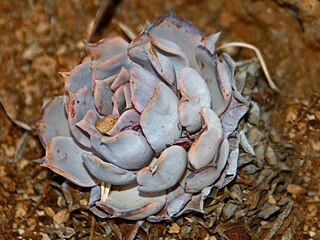
Echeveria lilacina, common name ghost echeveria or Mexican hens and chicks, is a species of succulent plants in the genus Echeveria belonging to the family Crassulaceae.
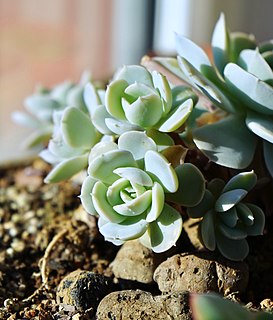
Echeveria runyonii is a species of flowering plant in the family Crassulaceae, that is native to the state of Tamaulipas in Mexico. Several cultivars have been described and cultivated.

Echeveria desmetiana, incorrectly known as Echeveria peacockii, is a succulent plant in the family Crassulaceae. L. de Smet was the first grower of this plant.

Echeveria derenbergii, the painted-lady, is a species of flowering plant in the family Crassulaceae, endemic to Mexico.
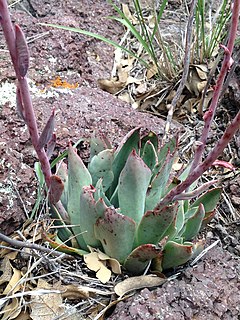
Echeveria strictiflora, the desert savior, is a species of flowering plant in the family Crassulaceae, native to southwestern Texas and to the Chihuahuan Desert of northeast Mexico. Its range consists of several scattered populations, rather than a contiguous range.

Echeveria nodulosa is a species of flowering plant in the Crassulaceae family. It is commonly called painted echeveria, and is native to Mexico.

Echeveria multicaulis is a species of plant native to Mexico. It is a member of the genus Echeveria.
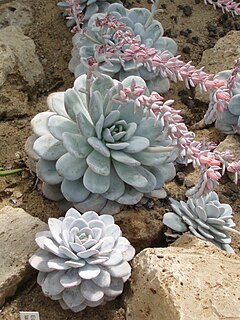
Echeveria laui is a slow-growing perennial succulent plant native to the state of Oaxaca, Mexico. It is a popular decorative plant due to its distinctive pink color.
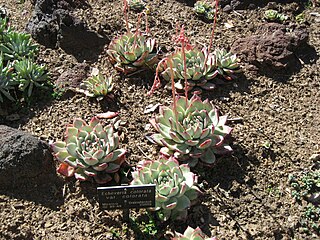
Echeveria colorata, is a species of flowering plant in the family Crassulaceae, endemic to Mexico.
Echeveria atropurpurea is a species of succulent plant in the Crassulaceae family. It is a perennial commonly known as chapetona or siempreviva, and is a endemic to Central Veracruz, Mexico in tropical deciduous forests. It is noted for its fast growing, easy cultivation, and red to yellow flowers. It is currently threatened by habitat loss.

Echeveria chihuahuaensis, sometimes Echeveria chihuahuensis, is a species of perennial flowering plant in the family Crassulaceae. It is native to Mexico. It is a diploid species, with a chromosome count of 50.

Dudleya cymosasubsp. cymosa is a species of succulent perennial plant in the family Crassulaceae native to California. It is the autonymous subspecies for Dudleya cymosa, and is known by the common name canyon liveforever. It is native to the California Coast Ranges, the Sierra Nevada and the Santa Monica Mountains. It is characterized by bright-yellow, orange or red flowers and broad, wide leaves. This plant is commonly found growing on rocky outcrops, talus slopes, and in shaded canyons.




















